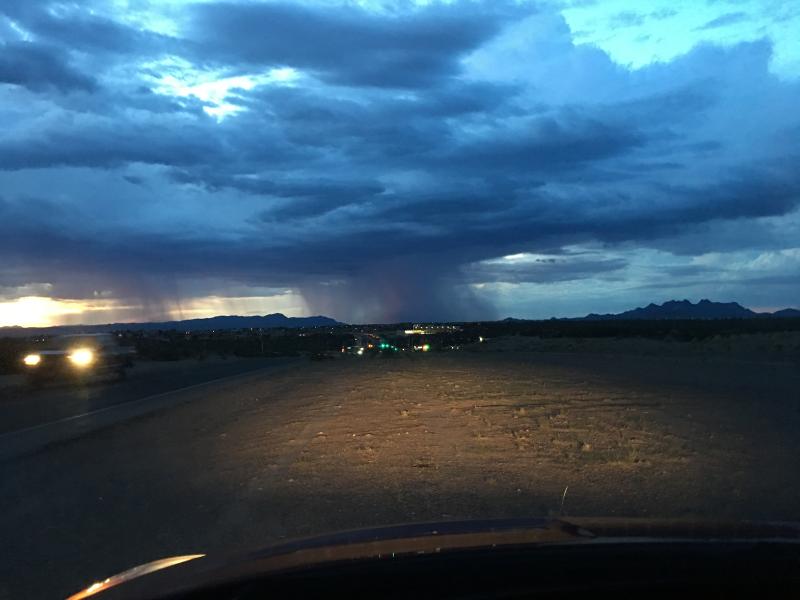'Everybody's tired': South Dakota tribe sues US over crime



Holly Wilson had just left to pick up soda for a steak dinner for her nine grandchildren last May, when a barrage of bullets was fired into her home on the largest Native American reservation in South Dakota.
Her 6-year-old grandson, Logan Warrior Goings, jumped from the family's loveseat and raced across the room to his grandfather — and was shot in the head. It took at least 15 minutes for a single tribal law enforcement officer to arrive, but by then, the drive-by shooters were gone, and Logan — a “kind and gentle” boy who loved Xbox and his Siamese cat, Simon — was dead.
“He was the sweetest little boy,” said Wilson, 62. “He was so helpful for grandma. He was my best partner.”
Months later, a father and son who live near Wilson on the Pine Ridge Indian Reservation, home to the Oglala Sioux Tribe, were shot and killed by an intruder, and their bodies weren't found for six days, she said. Just a few nights ago, Wilson's oldest son was held at gunpoint in his home.
These types of crimes have become increasingly common on the 5,400-square-mile (14,000-square-kilometer) reservation. Only 33 officers and eight criminal investigators are responsible for over 100,000 emergency calls each year across the reservation, which is about the size of the state of Connecticut, tribal officials said. The officers and investigators are all federally funded — and the tribe says it's just not enough.
The tribe sued the Bureau of Indian Affairs and some high-level officials in July, alleging the U.S. is not complying with its treaty obligations nor its trust responsibility by failing to provide adequate law enforcement to address the “public safety crisis” on the reservation. The federal government countered in court documents that the tribe can't prove treaties force the U.S. to provide the tribe with its “preferred level of staffing or funding for law enforcement.” After two days of court proceedings this week, a judge said he would take the case under advisement.
“We need change. Everybody’s tired of the same old talk. It’s all talk, talk, talk every year after year, and our people have suffered for decades,” Oglala Sioux Tribe President Frank Star Comes Out told The Associated Press. “We believe now is the time to take that stand.”
The federal government has a trust duty to Indigenous nations and has made promises to tribes under treaty agreements, which should be read liberally and in favor of Native American tribes, explained Robert Miller, law professor at Arizona State University and an enrolled citizen of the Eastern Shawnee Tribe in Oklahoma.
“If federal law enforcement is woefully weak, which it is on most reservations, it’s not carrying out its duty as the trustee, as the guardian of Indian nations,” he said.
Indigenous nations have increasingly advocated for treaty rights, including hunting, fishing and education, in the courtroom, with some success. In 2020, the U.S. Supreme Court made its landmark McGirt decision, ruling that a large portion of eastern Oklahoma, promised in treaties to the Muscogee (Creek) Nation, would remain a reservation.
In court documents in this case, the Oglala Sioux Tribe points to treaties such as the 1868 Treaty of Fort Laramie, which states that if someone commits a crime against Native Americans, the U.S. will “proceed at once to cause the offender to be arrested and punished according to the laws of the United States, and also reimburse the injured person for the loss sustained.”
Star Comes Out said he hopes Oglala Sioux’s lawsuit, which was filed just days after the Northern Cheyenne Tribe in Montana filed a similar one, will help to serve as an example for other tribes in the Great Plains and beyond who are facing similar situations.
The South Dakota reservation, about 80 miles (130 kilometers) southeast of Rapid City, is located between the Nebraska border and the Bakken oil fields.
The location has made it convenient for both human and drug trafficking, explained Patricia Marks, an attorney with the tribe, while its lack of police has meant it's known as a “lawless area.”
“We’ve had a radical increase in guns, gun violence,” she said. “We’ve had a radical increase in hard narcotics. It is heroin. It’s fentanyl. It’s meth. It is things that are life threatening.”
Between January and June 2022, tribal law enforcement received 285 reports of missing persons, 308 gun-related calls and 49 reports of rape, Oglala Sioux officials said. There are typically only five tribal officers on any given shift, and response time for weapon-related calls can be anywhere from 40 minutes to an hour, Marks said.
In 2020, there were 155 more violent crimes reported by the Oglala Sioux tribal law enforcement compared to 2017, according to the Bureau of Justice Statistics.
Criminal jurisdiction in Indian Country is complicated and depends on whether the suspect, victim or both are Native American, and where the crime occurs.
The federal government, tribes and counties have tried to bolster public safety on reservations — where, in some locations, Native women are killed at a rate more than 10 times the national average — with approaches that include cross-commissioning agreements, expanding sentencing authority for tribes and programs that allow tribal prosecutors to try cases in federal court.
The landmark Tribal Law and Order Act of 2010, for example, expanded sentencing authority of tribal courts under certain conditions.
The Justice Department has also worked to increase funding given to tribes to address crime, including last year when officials announced it would award over $246 million in grants to Native communities to improve public safety and help crime victims.
But the tribe says none of this has been enough.
On the Pine Ridge Indian Reservation, the FBI has jurisdiction over a set of major crimes. But its closest office is in Rapid City, so it can take more than two hours for agents to arrive, explained Marks.
“For all practical purposes, it is the tribal police who are the first responders regardless of the type of crime,” she said. “They’re the ones that have to get out there and answer the call."
The tribe would need over 140 more police officers on the reservation to fight the rampant crime, according to court documents.
JoAnn Sierra, 79, a member of the Oglala Sioux Tribe, said two of her sons and two of her grandsons were killed on or near the reservation. The most recent case involved her grandson, Justin Little Hawk, 40, who in November 2020 was ambushed by a man he did not recognize while driving two of Sierra’s teenage grandchildren, she said.
The man got in the backseat of Sierra’s car and shot Little Hawk after the other grandchildren ran out. He died shortly before Christmas, and the person responsible was never convicted, Sierra said.
“It just makes me feel like I’m lost … Why does this have to happen here?" Sierra asked. "Why didn’t I move?”
Since the death of Logan, who was given the Lakota name Petá Zi Hoksila, meaning Yellow Fire Boy, Wilson has plastered the reservation with signs that say things like, “Justice for Logan” and “Who killed grandma’s baby?” in hopes of bringing attention to his death.
She said after Logan was shot, she waited months to hear from the FBI, and when she tried to talk with tribal law enforcement, they were limited in what they could say due to jurisdictional issues.
Wilson said she believes if there had been more law enforcement responding quickly, her grandson’s case could have been solved.
“It’s sad that we had to take those measures as a tribe to get the help that should have been there," she said through tears. "It should have been there according to the treaties. And yet we all had to live like this. Lose people; lose loved ones.”





There are approximately 326 Indian land areas in the U.S. administered as federal Indian reservations (i.e., reservations, pueblos, rancherias, missions, villages, communities, etc.).
Under the reservation system, American Indians kept their citizenship in their independent tribes, but life was harder than it had been. The reservations were designed to encourage the Indians to live within clearly defined zones. The U.S. promised to provide food, goods and money and to protect them from attack by other tribes and white settlers. Also, some educators and protestant missionaries felt that forcing the Indians to live in a confined space would make it easier to "civilize the savages."
Native Indians, after 1830, found themselves being confined to reservations. But, even the Indian Territory was not safe from white settlers. In 1854, the Federal Government closed the northern half of Indian Territory and created the Kansas and Nebraska Territories. They were immediately opened up to white settlement. Many of the tribes living on the land ended up on much smaller reservations.
The reservation system was a disaster for the Indians as the government failed to keep its promises.
There are more than 6.79 million American Indian and Alaska Native people who live in America and 576 federally recognized Indian nations across the country, each with distinctive histories of colonization since European contact. Then there are state-recognized nations, unrecognized nations, and Indigenous communities living in the diaspora, too.
While people in a single community will provide a range of perspectives — much less in all 576 federally recognized tribes — more often than not, a version of one answer always comes up about what the US needs to do: honor the treaties.
The US government signed 370 treaties with numerous Indigenous nations from 1778 to 1871. While the language in the treaties is diverse, there are often certain common features of the pacts: a guarantee of peace, a definition of land boundaries, preservation of hunting and fishing rights, and provisions for protection against domestic and foreign enemies.
“It’s sad that we had to take those measures as a tribe to get the help that should have been there," she said through tears. "It should have been there according to the treaties. And yet we all had to live like this. Lose people; lose loved ones.”
True Mrs. Wilson - and the question on everyone's mind is - why won't the U.S. step up and honor their treaties?????
Is it illegal for reservations to have their own police forces?
I know that the Federal government is supposed to take care of enforcement on the reservations; but it is obviously not up to the job.
If the government will not supply adequate enforcement- then it should provide adequate funding so the tribes can train, hire, and maintain their own law enforcement.
Tribes/Nations do have their own police forces, but they don't have the budgets needed for proper personnel, equipment, training, etc.
Originally, the police on the reservations were Bureau of Indian Affairs (BIA) employees who were Native Americans of the tribe, but they were always under the supervision of the Agency. In fact, many of the reservations have three "law enforcement" operations - the BIA, FBI and tribal - which is where many of the issues have arisen due to who claimed/has jurisdiction over which type of case.
The superficial description of Indian Country law enforcement shows a rural environment with rural-style policing. Imagine an area the size of Delaware, but with a population of only 10,000, that is patrolled by no more than three police officers and as few as one officer at any one time -—a level of police coverage that is much lower than in other areas of the country. Most departments are administered by tribes (through a contract between the tribe and the Bureau of Indian Affairs [BIA]), but many are administered directly by BIA.
There have been "some" improvements due to the passage of the Tribal Law and Order Act and the Reauthorization of the Violence Against Women Act with requirements for upgrading the Tribal/Nation law enforcement jurisdiction. In 1978, the Supreme Court case Oliphant v. Suquamish stripped tribes of the right to arrest and prosecute non-Indians who commit crimes on Indian land. If both victim and perpetrator are non-Indian, a county or state officer must make the arrest. If the perpetrator is non-Indian and the victim an enrolled member, only a federally certified agent has that right. If the opposite is true, a tribal officer can make the arrest, but the case still goes to federal court.
So, who does what with whom where and when creates many of the problems/challenges the tribes/nations face.
Thank you for the response.
Then the US government needs to fund them. Like they do so many police forces across the country. I am sure they can come up with a creative way to put wordage into the next multi billion dollar aid package to Ukraine. I would say just divert some funds away from special pork projects and government waste; but that will never happen.
Sounds like this should be getting handled at the local level; since the federal government obviously isn't up to the task. It can provide oversight and some guidance- but the day to day functioning needs to be handled by local authorities.